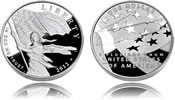1971-1974 "Blue Ikes" were issued by the United States Mint as uncirculated collector grade versions of circulating Eisenhower Dollars. Unlike their base metal counterparts struck for commerce, the Blue Ikes were struck from 40% silver.
Eisenhower Dollars made their debut in 1971 and featured an obverse portrait of Dwight D. Eisenhower. He was a five-star General of the United States Army and Supreme Commander of the Allied forces in Europe during World War II.
Following his military service, Eisenhower turned to the political spectrum and ran for President of the United States in 1952. He was elected and became the 34th President serving two terms from 1953 to 1961.
Eisenhower passed away on March 28, 1969, and a movement was begun almost immediately to place his likeness on a circulating coin of the United States. That movement came to fruition with the release of the Eisenhower Dollars in 1971.
The United States Mint released two collector grade versions of the Eisenhower Dollars. One version came to be known as the "Blue Ikes" or "Blue Eisenhower Dollars." These coins were struck to uncirculated quality at the US Mint’s facility in San Francisco and carry the ‘S’ mintmark.
These coins were placed in a pocket of a cellophane sheet with a blue token placed in another pocket. This sheet was then put inside a blue outer envelope thus giving the release its nickname.
The other collector grade version issued by the US Mint of the Eisenhower Dollar is nicknamed the "Brown Ikes." These coins are proof quality and came in a brown colored box.
Eisenhower Dollars feature an obverse portrait of Dwight D. Eisenhower as designed by Frank Gasparro. The reverse shows a design based on the Apollo 11 Mission Insignia also created by Gasparro.
1971-1974 Blue Ike Specifications
| Face Value: | $0.50 | |
| Composition: | 40% silver | |
| Total Silver Content: | 0.3161 oz |
 The commemorative
The commemorative  The commemorative
The commemorative 